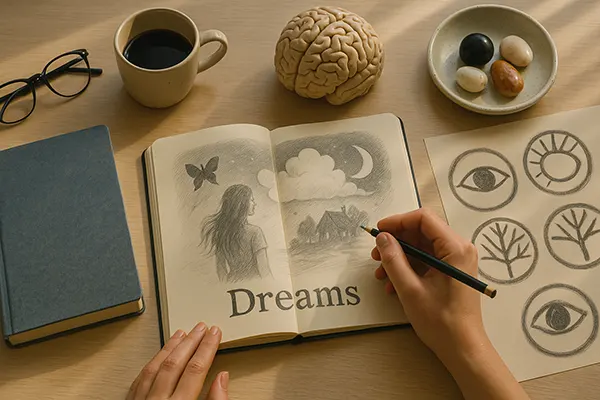
Sleep is not just a necessity — it can be an extraordinary psychological journey. As the boundaries between consciousness and dreams blur, the night becomes a space of self-discovery. From fleeting hypnagogic images to the thrill of lucid dreams, your mind crafts entire worlds that reflect your inner self. Understanding these dream phenomena not only reveals how your brain functions but also offers insight into your emotions, fears, and desires.
Understanding Hypnagogic Imagery: The Gateway Between Wakefulness and Sleep
Hypnagogic imagery refers to the fleeting sensory experiences that occur during the transition from wakefulness to sleep. These visual, auditory, or tactile impressions can be brief yet powerful, often reflecting thoughts, concerns, or memories from the day. Common examples include flashes of light, shapes morphing into faces, or random snippets of conversation. While usually abstract, they reveal how your brain processes and stores daily stimuli.
Researchers believe hypnagogic images arise from decreased activity in the prefrontal cortex, allowing spontaneous neural patterns to dominate. This momentary “disorganisation” results in bizarre, dream-like visuals. Unlike full dreams, these are unstructured and highly suggestible — if you’re thinking of a friend, you might see their face in a flash. Hypnagogic images offer a direct line to your subconscious, unfiltered by logic or reason.
Experiencing these visuals frequently may be linked to high levels of creativity, anxiety, or even sleep deprivation. While they’re not pathological, they’re more common in those with rich imaginations or irregular sleep patterns. Learning to observe these images without reacting can be a step toward lucid dreaming or meditative sleep states.
The Psychological Significance of Hypnagogic States
Psychologically, hypnagogia acts as a mirror of your mental state. People undergoing stress may witness chaotic or disturbing visuals, while those in a calm, relaxed state might observe soothing, abstract patterns. This makes hypnagogic imagery a valuable tool for self-reflection. Just as journaling captures your conscious mind, hypnagogic experiences tap into the unconscious.
Artists, philosophers, and scientists have historically reported breakthroughs during hypnagogic states. Salvador Dalí and Thomas Edison even used techniques to deliberately hover in this state, claiming it spurred creativity. These moments between wakefulness and sleep are ripe for problem-solving and idea generation, as logic loosens its grip and imagination runs free.
Moreover, hypnagogic imagery can highlight unresolved emotional content. Night after night, repeated images may indicate something your conscious mind refuses to confront. Recognising and processing these symbols can lead to greater emotional resilience and mental clarity during waking hours.
Lucid Dreaming: Exploring the World Within
Lucid dreaming occurs when you become aware that you’re dreaming while still within the dream. This awareness often allows individuals to control the events of the dream — to fly, walk through walls, or revisit important memories. While not everyone experiences lucid dreams spontaneously, techniques exist to cultivate the skill deliberately and safely.
During a lucid dream, the dorsolateral prefrontal cortex — typically inactive during REM sleep — lights up, enhancing self-awareness. This partial reactivation allows dreamers to think critically, assess the dream’s reality, and exert a degree of influence over it. It transforms sleep into a conscious adventure and provides a unique space for inner exploration.
Recent studies confirm that lucid dreaming can improve problem-solving, reduce recurring nightmares, and support mental wellness. Some therapists even incorporate dream control training into treatment for PTSD, as patients can re-script traumatic dreams and regain a sense of control. The therapeutic potential of lucid dreams is steadily gaining mainstream attention in psychology.
How to Develop and Control Lucid Dreams
Developing lucid dreaming begins with dream recall — keeping a journal next to your bed and writing down dreams immediately upon waking. Over time, this improves memory and encourages awareness of dream patterns. Reality checks, such as asking yourself if you’re dreaming throughout the day, train the mind to question reality within dreams as well.
Another common technique is MILD (Mnemonic Induction of Lucid Dreams), where before sleep, you repeat a phrase like “I will realise I’m dreaming.” This sets the intention and increases the likelihood of lucidity. For advanced dreamers, WBTB (Wake Back to Bed) involves waking up after 4-6 hours of sleep, staying awake briefly, and then returning to bed — a method proven to increase lucid episodes.
Controlling a lucid dream can take time. Beginners may wake up once they become aware, but with practice, stabilisation techniques — like spinning in the dream or focusing on one object — help prolong the experience. Over time, dreamers can masterfully navigate their dreams, using the space for creativity, healing, or self-discovery.

What Your Dreams Reveal About You
Dreams reflect more than just fragmented thoughts — they are symbolic narratives built from your memories, emotions, and perceptions. Whether lucid or not, dreams serve as a nightly psychological report card. Understanding the themes, emotions, and symbols that recur in your dreams can offer profound insights into your personality, fears, and desires.
According to Carl Jung’s theory, dreams are a dialogue between the conscious and unconscious mind. Archetypes such as the “shadow” (repressed traits), “anima/animus” (inner femininity/masculinity), and the “self” frequently appear in symbolic form. Recognising these elements in your dreams can help integrate different aspects of your psyche and support personal growth.
Even the absence of control in dreams is meaningful. Chaotic or fragmented dreams can signal psychological distress, burnout, or anxiety. Alternatively, peaceful, vivid dreams often reflect emotional balance. The patterns in your sleep architecture — including the frequency of REM cycles or the presence of lucid dreaming — are clues to your overall mental state.
Dreams as a Tool for Self-Discovery
By regularly analysing your dreams, you can uncover blind spots in your waking life. Recurring dreams often point to unresolved issues, while dream characters can represent parts of yourself that you neglect or suppress. Confronting these elements in a dreamscape can help process trauma or anxiety in a non-threatening environment.
Many find it helpful to explore their dreams through art, writing, or therapy. Drawing dream imagery or composing music inspired by dreams allows creative expression of unconscious themes. Jungian dream therapy, in particular, helps individuals decode symbolic content and understand how it relates to life experiences and emotional health.
Ultimately, your dreams are yours alone. They are crafted by your experiences, personality, and emotional state. Taking the time to engage with them — whether through lucid exploration or reflective journaling — can lead to deeper self-understanding and a more integrated sense of self.